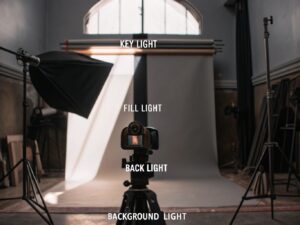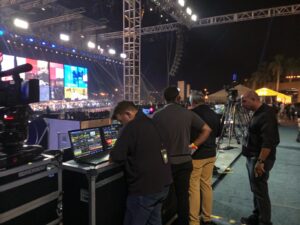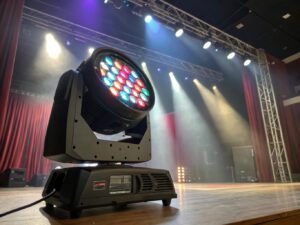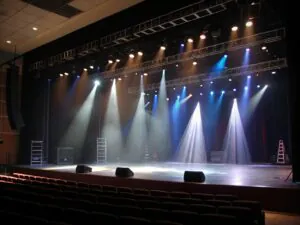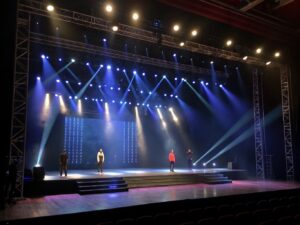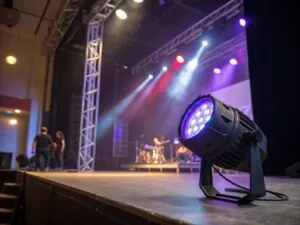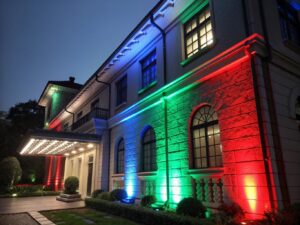
Choosing stage lights feels overwhelming. Bad lighting can ruin a great show. I'll guide you through picking the best lights to make your stage truly shine.
The best lighting isn't one single fixture. It's a smart combination of different lights. You need washes for broad color, spots for focused areas, and beams for sharp, dramatic effects. Together, they create a complete and dynamic stage look1 that captivates the audience.

I've spent nearly two decades in this industry, from hauling gear to designing entire systems. I've learned that understanding why you use a certain light is more important than just knowing its name. The 'best' light is the one that does the job you need it to do. To really answer the main question, we need to break it down. Let's start with what actually makes stage lighting 'good' in the first place. You'll be surprised how simple the core ideas are.
What is good stage lighting?
Ever see a show with flat, boring lighting? It can completely ruin the mood. Let's break down the simple elements that separate "good" lighting from the bad.
Good stage lighting effectively supports the performance. It ensures visibility2, directs the audience's focus, creates the right atmosphere3, and adds a layer of visual excitement without being distracting. It should feel intentional and enhance the story being told on stage.

Good lighting does more than just help people see. It has four main jobs. I always think about these four things when I design a lighting plan. Balancing them is the key to creating a professional look4.
Visibility is King
First and foremost, the audience has to see the performers. If an actor's face is in shadow during a key line of dialogue, the moment is lost. Proper illumination is the foundation of everything else we do.
Directing the Eye
As a lighting technician, you are the audience's guide. You use light to tell them where to look. A bright spot on a soloist or a darkened stage with one illuminated prop immediately draws attention. It's a powerful tool for storytelling.
Painting with Emotion
Color is a universal language. Warm ambers can create a cozy, happy scene. Deep blues can evoke sadness or mystery. Red can mean passion or danger. Choosing the right colors is like creating a soundtrack for the eyes.
Creating "Wow" Moments
This is about using effects to enhance the action. The sharp, slicing beams during a guitar solo, or a slow, patterned gobo wash during a ballad. These effects must support the performance, not overpower it.
| Feature | Good Lighting | Bad Lighting |
|---|---|---|
| Visibility | Actors are clearly seen | Faces in shadow, key moments missed |
| Focus | Highlights the main action | Distracting lights in the background |
| Mood | Colors match the scene's emotion | Clashing or inappropriate colors |
| Effect | Enhances the performance moment | Random, overused, or distracting effects |
What is the most popular stage light?
With so many lights available, which one do you actually need? Choosing wrong means wasted money. I'll show you the most popular and versatile fixture in modern stage lighting.
Today, the LED Moving Head is the most popular stage light. Its versatility is unmatched. It can function as a wash, a spot, or even a beam light, all in one unit. It also offers color mixing5, gobos, and movement, making it the workhorse for many productions.

Back in the day, my prep for a big show involved a lot of heavy lifting. We needed separate PAR cans for color washes, heavy profile spots for gobos, and specific effect lights for anything special. The moving head fixture changed the game completely.
The All-in-One Solution
I've worked with many technicians like Nick who can build an entire, dynamic rig using mostly moving heads. Why? Because one fixture can do three or four jobs. It can flood the stage with color for one scene. Then, in an instant, it can snap to a tight beam on a performer for the next scene. This versatility saves time, space, and a lot of effort during setup.
The Power of LED Technology
The shift from traditional lamps to LED was another huge leap forward. LEDs use far less power, which is a big deal for any venue. They also produce very little heat, making the stage much more comfortable for performers. Modern LED engines are incredibly bright and offer fantastic color mixing, so you are not limited by the physical color gels you have on hand. It's a true lighting tool in a single, efficient package.
| Feature | LED Moving Head | Traditional Fixtures (Separate) |
|---|---|---|
| Functionality | Wash, Spot, Beam, FX in one | One function per fixture |
| Flexibility | Reposition/re-color instantly | Requires manual refocusing/gel changes |
| Energy Use | Low | High |
| Heat Output | Low | High |
What type of light is used for stage lighting?
Beyond moving heads, what other lights complete a professional rig? Focusing on just one type can limit your designs. Let’s explore the essential categories of stage lights.
Stage lighting uses several key types of lights. These include wash lights for broad coverage, spot lights for focused beams and patterns (gobos), beam lights for sharp, aerial effects, and PAR cans, which are simple, durable floodlights. These fixtures form the core toolkit for any lighting designer.

A good lighting rig6 is like a painter's palette. You need different brushes for different types of strokes. You wouldn't paint a whole masterpiece with just one brush, and you can't light a great show with just one type of light. Here are the main tools we use.
Wash Lights
These are your broad paintbrushes. Their job is to cover large areas of the stage with an even field of color. They are perfect for setting the base color and overall mood of a scene.
Spot Lights
These are your fine-detail brushes. They create a hard-edged, focused circle of light. We use them to isolate and highlight a single performer or a small area. Most spots can also hold gobos, which are stencils that project patterns like windows or trees.
Beam Lights
These are the most aggressive and exciting lights. As I mentioned in my insights, beam lights have amazing stage effects. They produce a very tight, powerful column of light that looks like a laser. They are perfect for cutting through haze and creating stunning mid-air effects in concerts and high-energy events.
| Light Type | Primary Use | Best For |
|---|---|---|
| Wash Light | Broad, even color coverage | Setting mood, general illumination |
| Spot Light | Focused beam, patterns (gobos) | Highlighting performers, creating texture |
| Beam Light | Aggressive, narrow light columns | Concerts, high-energy effects, aerials |
| PAR Can | Simple flood or wash of light | Basic color washes, backlighting |
What is the basic rule for lighting a stage?
Got the right lights but unsure where to aim them? Bad placement creates harsh shadows and can ruin a performer's look. I’ll share the most fundamental rule for lighting a stage.
The most basic rule is based on the McCandless Method7, a three-point lighting system. You light a subject from two different front angles, typically 45 degrees left/right and 45 degrees up. A backlight from behind separates them from the background.

The most famous method is called the McCandless Method. But don't let the name scare you. It’s just a simple, effective way to make a performer on stage look natural and three-dimensional. It breaks down into three main lights.
The Key Light: Your Main Source
This is the primary and brightest light on your subject. It usually comes from about 45 degrees to one side and 45 degrees up. This light defines the shape of the performer's face. By itself, it would create strong shadows.
The Fill Light: Softening Shadows
To fix the shadows from the key light, you add a fill light. It comes from the other side, also about 45 degrees over and up. It is less bright than the key light. Its only job is to "fill in" the dark shadows so the face is evenly lit. Often, we'll make the key light a warm color and the fill light a cool color for a more natural look.
The Back Light: Creating Depth
This light comes from behind the performer. It hits their head and shoulders. This creates a subtle outline of light that visually separates them from the background. Without a backlight, a performer can look flat, almost like they are part of the scenery. It's the final touch that makes them "pop."
Conclusion
Choosing the best stage light means matching the right tool to the job. Combine washes, spots, and beams, and apply basic three-point lighting for a professional and unforgettable show.
-
Learn how to create a captivating and dynamic stage look with effective lighting techniques. ↩
-
Learn how proper visibility can significantly impact audience engagement during performances. ↩
-
Explore the role of lighting in setting the mood and enhancing the overall atmosphere. ↩
-
Discover tips on achieving a polished and professional appearance through effective lighting. ↩
-
Explore the art of color mixing and how it can evoke emotions in your audience. ↩
-
Understand the components and setup of a lighting rig for professional shows. ↩
-
Explore this effective three-point lighting technique to enhance your stage lighting setup. ↩
You may also be interested in:
